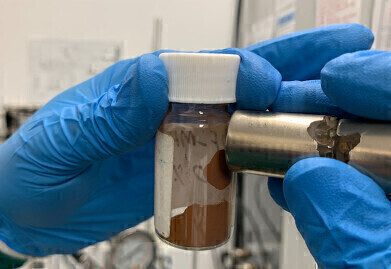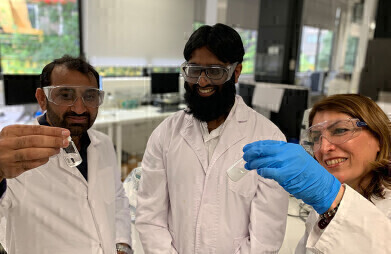-
 Microplastics magnet
Microplastics magnet -
 Microplastics team Dr Nasir Mahmood, PhD candidate Muhammad Haris and Prof Nicky Eshtiaghi
Microplastics team Dr Nasir Mahmood, PhD candidate Muhammad Haris and Prof Nicky Eshtiaghi
Environmental Laboratory
Magnets used in ingenious way to remove hazardous microplastics rapidly from water
Dec 05 2022
It can take several days to remove microplastics from water however, researchers from the Royal Melbourne Institute of Technology (RMIT) have developed an economical and sustainable solution that achieves better results than conventional methods in just an hour!
The solution is based around adsorbents, in the form of a powder, that extract microplastics up to 1,000 times smaller than those currently detected in wastewater treatment plants.
The adsorbents have been tested successfully the in the lab, and the team from RMIT plan to work with the water sector to develop the innovation to remove microplastics from waterways cheaply and effectively.
Professor Nicky Eshtiaghi, one of the project’s lead researchers, stated, “The nano-pillar structure we’ve engineered to remove this pollution, which is impossible to see but very harmful to the environment, is recycled from waste and can be used multiple times. This is a big win for the environment and the circular economy.”
The adsorbent was developed using nanomaterials that can be mixed into water and they in turn attract microplastics and dissolved pollutants.
First author and PhD candidate from the RMIT’s School of Engineering, Muhammad Haris said that, as the nanomaterials contained iron, magnets separate the microplastics and pollutants from the water quickly and easily.
Co-lead researcher Dr Nasir Mahmood, co-lead researcher from RMIT’s School of Science commented “The adsorbent is prepared with special surface properties so that it can effectively and simultaneously remove both microplastics and dissolved pollutants from water. Microplastics smaller than 5 millimetres, which can take up to 450 years to degrade, are not detectable and removable through conventional treatment systems, resulting in millions of tonnes being released into the sea every year. This is not only harmful for aquatic life, but also has significant negative impacts on human health.”
Professor Eshtiaghi added “Our powder additive can remove microplastics that are 1,000 times smaller than those that are currently detectable by existing wastewater treatment plants. We are looking for industrial collaborators to take our invention to the next steps, where we will be looking at its application in wastewater treatment plants.”
Digital Edition
Asian Environmental Technology 27.2 - April/May 2023
May 2023
In This Edition Business News - Celebrating The Life Of A Gas Measurement Industry Icon - A New Home For Gas Sensor Specialists - Envea Completes The Acquisition Of Hycontrol Ltd Environ...
View all digital editions
Events
Jul 02 2023 Albena, Bulgaria
Jul 04 2023 Cardiff, UK
Jul 05 2023 Johannesburg, South Africa
Jul 11 2023 Shanghai, China
Jul 11 2023 Lagos, Nigeria




















